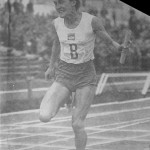 While Castor Semenya’s recent “news” seems to have shocked the world, the concern about “gender verification” in sport has taken place for quite some time. The tests have changed over time…but the point has not (e.g. when women are “too good,” they must not be women).
While Castor Semenya’s recent “news” seems to have shocked the world, the concern about “gender verification” in sport has taken place for quite some time. The tests have changed over time…but the point has not (e.g. when women are “too good,” they must not be women).
Some examples of other intersex track athletes include:
- Stella Walsh, a 2 time Olympic medalist in the 1930s, running for Poland. She won a gold medal in ’36 in the 100 meter dash during the Berlin Olympics. It was only when she died that an autopsy revealed that she had male genitalia, XX chromosomes, and XY chromosomes as well.
- Eva Klobukowska, a Polish sprinter who won a gold medal in the 1964 Tokyo Olympics failed a sex chromosome test in 1965. She was banned from competition. (She gave birth a few years later).
- Maria Patino from Spain was a sprinter and failed a “gender” test in 1985—she was banned from sports competition but was reinstated later when it became clear that she was resistant to testosterone. Since she was deemed resistant to testosterone, the fear that she had an “unfair advantage” or was “a man unfairly masquerading as a woman” was squelched.
- Santhi Soundarajan, an Indian runner who failed a gender test in Doha in 2006 and was stripped of a previous medal.




The list goes on and on. And then, most recently, there was South African Caster Semanya.
Semenya was subject to a “gender verification test” (it is a sex test not a gender test). She was born female, raised as a woman, identifies as a woman, and has no ovaries or uterus. She also has undescended testes. It was also found that while she produces “10 times less” testosterone than “most men,” she has exceeded the average of women by “3 times.” (Why are we comparing elite athletic women to “average women” who may not train as rigorously or build muscle mass as much)? Unlike many other countries which stand by and allow international governing bodies to carry out these tests and toss their athletes out of sports competitions forever more, the South African parliament filed a complaint with the United Nations Human Rights Commission. The International Association of Athletics Federation wants her to be disqualified from future events and has suggested to her that she should have “immediate surgery” because of the “grave health risks” of her “condition.”
This is a complicated issue, but I will be brief here and spread my thoughts over a number of posts.
Let me at least say this: The International Olympic Committee mandated “gender verification” of women since the mid 1960s but in 1990, the International Amateur Athletics Federation called for the abandonment of gender verification. A working group was developed, and the Women’s Sports Foundation website reports that the working group concluded that:
- women with birth defects of the sex chromosomes did not possess an unfair advantage and should be permitted to compete as females; the only purpose of gender verification was to prevent men from masquerading as females;
- people who have been both legally and psychosocially female since childhood (including pre-pubertal sex re-assignments) should be eligible for women’s competition regardless of their chromosomal pattern;
- post-pubertal sex re-assignments should be handled on a case by case basis; and women athletes should undergo pre-participation health examinations.
Unfortunately, at IOC events, the IOC continues to sex test despite the discrimination it entails and the harm it causes to athletes.
What I would like to see is parallel gender verification treatment of male athletes:
Let’s determine the normal range of testosterone for men and if there are male athletes who naturally produce more than other male athletes—ban them from competition for being “too much of a man”? (Unnatural advantage).
The other men just don’t have a chance against them, do they?
All of the above trends are of course, contextualized in sport as a social institution, which, since its inception was formed by and for men, in order to make boys into men (for a history of these claims, see the following books: Michael Messner, Power at Play, Susan Cahn, Coming on Strong: Gender and Sexuality in 20th Century Women’s Sport, or Varda Burstyn’s, The Rites of Men. Another important piece of context: recognition that sport is constructed to explicitly segregate the sexes into two dichotomous beings who don’t compete with one another and to support ideologies of “the two sex system” (Ann Fausto-Sterling’s term, in her book Sexing the Body: Gender Politics and the Construction of Sexuality. She is a biologist, by the way). This is the case even though sport as an institution could be set up to reward the best sports performances (no matter where sex or sexes land).
For excellent work on the two sex system in sport (and for the inspiration for the title of this post), check out Ann Travers’ piece in Studies in Social Justice (2008, Volume 2, #1) “The sport nexus and gender injustice.”
…and don’t miss Mary Jo Kane’s 1995 “seminal” work in the Journal of Sport and Social Issues titled “Resistance/Transformation of the Oppositional Binary: Exposing Sport as a Continuum.”
Finally, if this topic is one that you just plain enjoy, I have a few of my own books on this topic, such as, Leslie Heywood & Shari Dworkin’s (2003): Built to Win: The Female Athlete as Cultural Icon (University of Minnesota Press), and Shari Dworkin and Faye Wachs (2009). Body Panic: Gender, Health, and the Selling of Fitness (NYU Press).

Comments 5
India officially recognizes third sex/gender » Sexuality and Society — November 13, 2009
[...] HIV/AIDS interventions?What will they say about ongoing controversies around intersexual athletes (such as the Indian runner, Santhi Soundarajan)? I will be watching with great [...]
seelenlos — November 22, 2009
since you quoted that semenya should have "immediate surgery" because of the "grave health risks" of her “condition" (usually gonadectomy because of "high cancer risk") without further comment, i hope you're well aware that such generalised surgeon's talk is a lie? with some exceptions, most intersexed people have an exceptionally low cancer risk!
http://zwischengeschlecht.org/pages/Semenya-Soundarajan-Discrimination-of-Hermaphrodites-in-Sports
thanks for the hint at the women's sport foundation, interesting. especially like their stand that the sole reason for exclusion should be masquerade (i.e. "normal men" disguising as women).
however, as an ally working for a human rights group fighting for human rights for the intersexed, it is my understanding that, while the abolition of mandatory sex tests was beneficiary for "normal women", it made the situation worse for (suspected) intersex athletes, see eg. the treatment of santhi and caster, which as i understand it is a step back to something that seemed long overcome when the tests were abolished after maria's legal victory. where are they now, the "medical authorities" who helped maria patino?
justice for santhi soundarajan!
oca, give santhi her medal back! NOW!!
http://zwischengeschlecht.org/pages/Justice-for-Santhi-Soundarajan-and-Caster-Semenya-Rally-19.11.09
Top Ten Sexual Stories of 2009 » Sexuality and Society — December 31, 2009
[...] 5. Panic-over-sex/gender/sexuality-fluidity stories, starring: Caster Semenya! 18 year old Caster Semenya got a makeover Ceara Sturgis, fighting for her right to wear a tux for [...]
The Athletic Sex « ibelmont — November 13, 2011
[...] “Recognition that sport is constructed to explicitly segregate the sexes into two dichotomous ... [...]
Intersex | Gender and Sexuality According to Kari — May 24, 2013
[...] article brings me to think about how sports are usually divided into men’s and women’s sports. This is a situation where it may be [...]